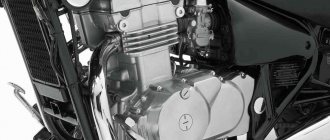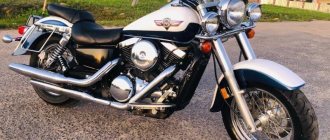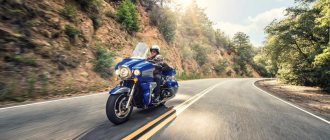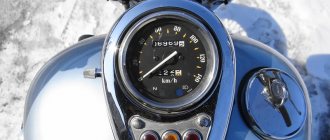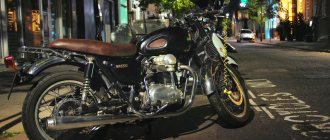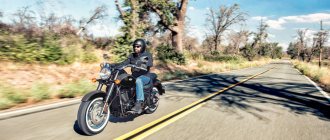| Kawasaki Vulcan S (2014-2020) | Kawasaki Vulcan S Special Edition (2017-2020) | Kawasaki Vulcan S Cafe' (2017-2020) |
| Kawasaki Vulcan S (2021+) | Kawasaki Vulcan S Cafe' (2021+) |
Cruiser model Kawasaki Vulcan S
was first introduced in 2014 as a 2015 model.
The motorcycle is a modern successor to the Kawasaki EN500 Vulcan. The model also has a name - Kawasaki EN650 Vulcan
.
The motorcycle was based on the engine from the Kawasaki ER-6 and Kawasaki Versys 650, which was slightly retuned (decreased maximum power, increased torque characteristics in the low and mid-range zone) and placed in a steel diamond-shaped frame, giving an overall appearance similar to Harley -Davidson V-rod.
In 2021, in addition to the main version of the motorcycle, two others also appear, differing mainly only in color schemes:
- Kawasaki Vulcan S Special Edition
- Kawasaki Vulcan S Cafe
Among the features of the motorcycle, the in-line 2-cylinder engine with a volume of 649 cc should be highlighted. cm (producing 61 hp of power and 63 Nm of torque), steel diamond-shaped frame, disc brakes front and rear (available in versions with ABS), electronic fuel injection, 6-speed gearbox, chain drive to the rear wheel and fuel tank for 14 l.
In general, the concept of the Kawasaki Vulcan S is to offer the market a motorcycle with a brutal appearance, reminiscent of the design of power cruisers, but in terms of equipment and character comparable to the usual modern road motorcycles (light weight, comfortable fit, medium-displacement engine, good dynamic characteristics, efficiency).
The main competitors of the Kawasaki Vulcan S in the class:
- Honda CTX 700
Brief history of the model
- 2014 - start of production and sales of the Kawasaki Vulcan S model.
Model:
Kawasaki Vulcan S / Vulcan S ABS (all markets).
Factory designation:
EN650AHF.
- 2015 - no significant changes.
Model:
Kawasaki Vulcan S / Vulcan S ABS (all markets).
Factory designation:
EN650AFF / EN650BFF.
- 2016 - on all European versions of the Kawasaki Vulcan S, ABS is included as standard on the motorcycle.
Model:
Kawasaki Vulcan S / Vulcan S ABS (all markets).
Factory designation:
EN650AGF / EN650BGF.
- 2017 - Special Edition and Cafe versions appeared.
Model:
Kawasaki Vulcan S / Vulcan S ABS, Kawasaki Vulcan S Special Edition, Kawasaki Vulcan S Café' (all markets).
Factory designation:
EN650AHF, EN650CHF, EN650DHF, EN650EHF.
- 2018 - no significant changes.
Model:
Kawasaki Vulcan S / Vulcan S ABS, Kawasaki Vulcan S Special Edition, Kawasaki Vulcan S Café' (all markets).
Factory designation:
EN650CJF, EN650DJF, EN650EJF.
- 2019 - no significant changes.
Model:
Kawasaki Vulcan S / Vulcan S ABS, Kawasaki Vulcan S Special Edition, Kawasaki Vulcan S Café' (all markets).
Factory designation:
EN650CKF, EN650DKF, EN650EKF.
- 2020 - no significant changes.
Model:
Kawasaki Vulcan S / Vulcan S ABS, Kawasaki Vulcan S Special Edition, Kawasaki Vulcan S Café' (all markets).
Factory designation:
EN650CLF, EN650DLF, EN650ELF.
- 2021 - no significant changes.
Model:
Kawasaki Vulcan S / Vulcan S ABS, Kawasaki Vulcan S Café' (all markets).
Factory designation:
EN650CMFAL (Vulcan S), EN650DMFAL (Vulcan S ABS), EN650EMFNL (Vulcan S Café').
- 2022 - no significant changes.
Model:
Kawasaki Vulcan S / Vulcan S ABS, Kawasaki Vulcan S Café' (all markets).
Factory designation:
EN650CNFAL (Vulcan S), EN650DNFAL (Vulcan S ABS), EN650ENFNL (Vulcan S Café').
Tire selection
Both of these motorcycles are built from road bikes and are not choppers in the generally accepted sense. And they got the tires from road donors, and their size too. It won’t be easy to find something classic old-school cruiser in 17” sizes, so I don’t even recommend thinking about it. Buy something sporty and touring and be happy.
For a Honda with a 17” front wheel, the choice is wide. Not so long ago, 120/70 + 160/60 was the industry standard for 600 naked bikes and supermotos. There are no difficulties with the choice. If the financial issue is not pressing, then Michelin Road 5 or the previous model Pilot Road 4 and 3, Pirelli Angel GT and ST, Metzeler Roadtec 01, Dunlop Roadsmart III. If you are pressed, then pay attention to Shinko Verge 011 or budget series of famous manufacturers: Michelin Pilot Street Radial, Pirelli Diablo Strada, Metzeler Roadtec Z 6. If you want to add a little scrambler notes to the appearance of the motorcycle, then you can look at slightly toothy tires like Pirelli MT 60 RS Corsa or Heidenau K 73 Superrain. You can also install slicks, but it will look stupid.
The Kawasaki is a little more difficult because it has an 18" front wheel. This slightly narrows the list of models available as a set. Michelin will be available Pilot Road 3 and 4, but there will be no “fifth”, or Metzeler Roadtec Z 6-Z 8 and 01, Pirelli Angel GT and ST, Dunlop Roadsmart III and the same Shinko 011. Of the “something” options “more toothy” is only the Pirelli MT 60 RS Corsa.
Remember that any modern sports-touring tires exceed the grip capabilities, both power and geometric, of these motorcycles. Don’t get hung up on searching for just one brand – there are a lot of good tires in the world, and you can always find something tenacious, long-lived and inexpensive. You just need to know what and where to look.
www.motorezina.ru is the oldest online store for motor tires in RuNet..
Aluminum marathon > September 25, 2021 11:05 Mikhail Pimus
Specifications
Technical characteristics of Kawasaki Vulcan S:
| Model | Kawasaki Vulcan S |
| Motorcycle type | cruiser |
| Year of issue | 2014+ |
| Frame | steel tubular |
| engine's type | 2-cylinder, 4-stroke, in-line |
| Working volume | 649 cm³ |
| Bore/Stroke | 83.0 x 60.0 mm |
| Compression ratio | 10.8:1 |
| Cooling | liquid |
| Number of valves per cylinder | DOHC, 4 valves per cylinder |
| Fuel supply system | injector, 2x 38 mm |
| Ignition type | transistor |
| Maximum power | 61.0 hp (45 kW) at 7500 rpm |
| Maximum torque | 63.0 Nm (6.4 kgf*m) at 6600 rpm |
| Clutch | Multi-disc in oil bath, cable drive |
| Transmission | 6-speed |
| type of drive | chain |
| Front tire size | 120/70R18M/C 59H |
| Rear tire size | 160/60R17M/C 69H |
| Front brakes | 1 disc, 300 mm, 2-piston caliper (ABS) |
| Rear brakes | 1 disc, 250 mm, 1-piston caliper (ABS) |
| Front suspension | 41 mm telescopic fork, travel - 130 mm |
| Rear suspension | pendulum Uni-trak with monoshock absorber (7-step adjustable preload), stroke - 80 mm |
| Motorcycle length | 2310 mm |
| Motorcycle width | 880 mm |
| Motorcycle height | 1100 mm |
| Wheelbase | 1575 mm |
| Seat height | 705 mm |
| Minimum ground clearance (clearance) | 130 mm |
| Acceleration 0-100 km/h (0-60 mph) | 4.2 sec[1] |
| Maximum speed | 188 km/h[2] |
| Gas tank capacity | 14.0 l |
| Motorcycle weight (curb) | 225 kg – Vulcan S (2015-2016) 228 kg – Vulcan S ABS (2015-2016) 229 kg – Vulcan S ABS (2017+) 231 kg – Vulcan S Cafe |
Dimensions and weight
The dimensions of the bike are average. Its length reaches 2310 millimeters, its height is 1100 millimeters, and its width is 880 millimeters. Yes, you can’t call it large, but you can’t call it small either. The height of the motorcycle at the saddle is 705 millimeters. Wheelbase dimensions are 1575 millimeters.
The weight of the motorcycle is very moderate: the curb weight is 225 kilograms.
Which cruiser is the best?
But, meanwhile, which cruiser is the best according to the results of this comparative review? This is a rather difficult question because each of them has its own merits. The Honda motorcycle is easy to ride. Its transmission is smoother, its steering is lighter, its suspension is better, and its fuel efficiency beats that of its competitor. The Kawasaki motorcycle has a faster, more powerful powertrain, stronger brakes and is better suited for highway riding, as well as a more comfortable everyday ride. However, the gap between the two bikes in terms of drivetrain, handling and suspension is not too great, and my friend and I would rather buy a bike that has fewer gear changes and produces more power on the motorway, so we agreed with him is that we give our pick to the Vulcan S, which is the seat any of us would jump into first.
Suspension
One reason for this is that the CTX700N fork is mounted with a sportier 27.7° rake compared to the Vulcan S's 31° rake. The CTX700N is also slightly more compact than the Kawasaki and its 1529.08mm wheelbase is 45.72mm shorter than that of the Vulcan S. The Honda is also 7.48kg lighter than its rival. My scale showed its curb weight to be 219kg. And another plus in favor of the handling of this Honda motorcycle, as my journalist friend said, is the suspension of the CTX700N.
The suspension is very good and makes the CTX700N feel more luxurious than the Vulcan S. It has good low-speed damping and amazing acceleration ability. It holds the line well and actually encourages the rider to lean the bike a little more and take the next corner at a higher speed. Its suspension needs very little to dive into corners without difficulty.
At the same time, the CTX700N fork is “soft” and this is especially noticeable at high speeds. The Pro-Link rear shock springs better and absorbs impacts well, as it has 25.4mm more travel compared to the Vulcan S. With a 100kg rider on board, the Kayaba Kawasaki motorcycle shock often performs worse due to limitations of its stroke compared to its competitor.
When traveling at low speeds, such as around town, the Vulcan S's suspension feels a bit firm. You will feel this deficiency on the road. At high speed the motorcycle behaves better. During one of my trips, I hit a bump and jumped out of my seat because... the back of the motorcycle flew up on an obstacle
The handling benefit that's somewhat surprising is that the Vulcan S feels smaller, lower and more compact than the Honda. However, only one of these impressions is measurably true - the bike's stance is actually lower and its loaded seat height is 706.12mm. This makes the Vulcan S a better highway bike than the CTX700N. For motorway speeds, the Honda, with its pegs and high riding position, has a less comfortable riding position.
Appearance of cruisers
The main factor in the cruiser niche is appearance. Of course, the styling can be arbitrary, but the way the bike looks is the first thing that plays on the emotional chords of potential customers, those special guys who love cruisers. Honda motorcycles have a lot of plastic installed on them, from the body to the fuel tank covers. Its pipe is large and has a somewhat vague appearance, although it attracts quite a lot of attention. The CTX700N features a large, easy-to-see digital display mounted in a housing above the headlight. The large speedometer numbers are easy to read. There is a tachometer on top and a fuel gauge on the right.
With less elaborate bodywork, the Vulcan S leaves much less to the imagination, as much of the perimeter architecture of its tubular steel frame and Parallel Twin engine is visible from the outside. The chunky rear fender looks attractive, but I didn't like the bulky plastic housing for the taillight, turn signals and license plate. The Vulcan S's display is smaller. Below the round digital speedometer is the fuel gauge. The tachometer is a special device here. Its needle moves quickly across the dial as the driver revs his Vulcan S, which can be higher than his rival's. I looked at people's reactions from the outside and noticed that the Vulcan S was liked by more casual passers-by than the Honda.
Fuel efficiency
One final point worth noting is fuel efficiency. The CTX700N's fuel efficiency figure is impressive at 25.35 kilometers per liter. The Vulcan S, on the other hand, was less efficient and averaged 18.3 km/l during my testing. Thanks to the Vulcan S's larger 14-litre tank compared to its rival's 12-litre tank, refueling stops felt about the same, but the CTX was about 48km ahead of its competitor in total distance traveled.
Shifting gears
Since you'll be shifting more often in a Honda, it's a plus that the CTX700's gearbox shifts smoothly and the lever pull is light . The gears fall into place calmly and easily. On the Vulcan S, the transmission ratio allows the driver to get the most out of each gear, but shifts are not as clean as on the Honda. I also appreciated that the Vulcan S's 6th gear is more powerful than the CTX700's 6th gear, which is primarily an overdrive gear.
shifting the gears of these motorcycles on the highway, winding mountain roads, taking tight, tight turns that had to be negotiated at 25 km/h, traveling past mountains, cliffs and evergreen forests. The CTX700N shined on these roads. It was very stable and stable through corners. The Vulcan S, in turn, can corner at high speed, but in order for it to stay on the desired trajectory, it requires more work on the steering wheel. Both of these bikes exceed the capabilities of a typical cruiser, but the Honda's bike corners with less fuss and more stability.


